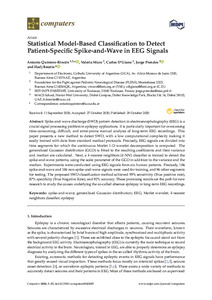Por favor, use este identificador para citar o enlazar este ítem:
https://repositorio.uca.edu.ar/handle/123456789/10947| Título: | Statistical Model-Based Classification to Detect Patient-Specific Spike-and-Wave in EEG Signals | Autor: | Quintero-Rincón, Antonio Muro, Valeria D’Giano, Carlos Prendes, Jorge Batatia, Hadj |
Palabras clave: | EPILEPSIA; ELECTROENCEFALOGRAFIA; ONDAS ENCEFALICAS; TECNICAS DE DIAGNOSTICO NEUROLOGICO | Fecha de publicación: | 2020 | Editorial: | MDPI | Cita: | Quintero-Rincón, A., Muro, V., D’Giano, C., Prendes, J., Batatia, H. Statistical Model-Based Classification to Detect Patient-Specific Spike-and-Wave in EEG Signals [en línea]. 2020, Computers, 9 (4). Disponible en: https://repositorio.uca.edu.ar/handle/123456789/10947 | Resumen: | Abstract: Spike-and-wave discharge (SWD) pattern detection in electroencephalography (EEG) is a crucial signal processing problem in epilepsy applications. It is particularly important for overcoming time-consuming, difficult, and error-prone manual analysis of long-term EEG recordings. This paper presents a new method to detect SWD, with a low computational complexity making it easily trained with data from standard medical protocols. Precisely, EEG signals are divided into time segments for which the continuous Morlet 1-D wavelet decomposition is computed. The generalized Gaussian distribution (GGD) is fitted to the resulting coefficients and their variance and median are calculated. Next, a k-nearest neighbors (k-NN) classifier is trained to detect the spike-and-wave patterns, using the scale parameter of the GGD in addition to the variance and the median. Experiments were conducted using EEG signals from six human patients. Precisely, 106 spike-and-wave and 106 non-spike-and-wave signals were used for training, and 96 other segments for testing. The proposed SWD classification method achieved 95% sensitivity (True positive rate), 87% specificity (True Negative Rate), and 92% accuracy. These promising results set the path for new research to study the causes underlying the so-called absence epilepsy in long-term EEG recordings. | URI: | https://repositorio.uca.edu.ar/handle/123456789/10947 | ISSN: | 2073-431X (online) | Disciplina: | MEDICINA | Derechos: | Acceso abierto | Fuente: | Computers Vol.9, No.4, 2020 |
| Aparece en las colecciones: | Artículos |
Ficheros en este ítem:
| Fichero | Descripción | Tamaño | Formato | |
|---|---|---|---|---|
| statistical-model-based-classification.pdf | 403,09 kB | Adobe PDF |  Visualizar/Abrir |
Visualizaciones de página(s)
86
comprobado en 30-abr-2024
Descarga(s)
176
comprobado en 30-abr-2024
Google ScholarTM
Ver en Google Scholar
Este ítem está sujeto a una Licencia Creative Commons

